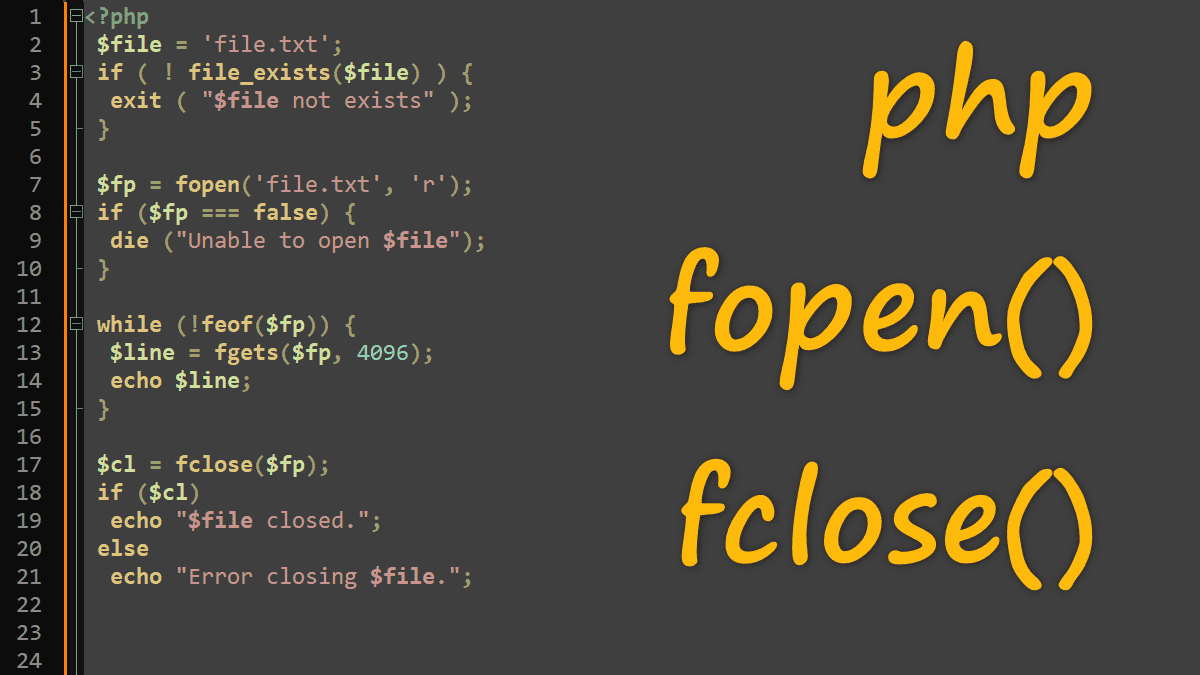For most file system functions, the files have to be opened first. The function fopen() does exactly this and returns a file handle, a pointer to the file. This file handle can then be used in subsequent functions to, for instance, read information from a file or write to it.
<?php
//Syntax
fopen(
string $filename,
string $mode,
bool $use_include_path = false,
?resource $context = null
): resource|false
fopen() expects at least two parameters:
$filename– The name of the file$mode– The file mode to use when accessing the file
The optional parameters:
$use_include_path– The optional third parameter can be set to ‘1’ or true if you want to search for the file in theinclude_path, too.$context– A context stream resource.
Example: Opening and Closing Files
The fopen function returns a file pointer resource on success or false on failure and the fclose function returns true on success or false on failure:
<?php
$fp = fopen('file.txt', 'r');
if ($fp === false)
die ('Error opening file');
echo 'File opened.';
$cl = fclose($fp);
if ($cl)
echo 'File closed.';
else
echo 'Error closing file.';
The fclose() function takes one parameter that must be a valid file resource, and points to a file successfully opened by fopen() ( or fsockopen()).
As soon as a file is not used anymore, it should be closed. PHP automatically closes all open files upon the termination of the script; however, to use the system resources as efficiently as possible, files should be closed as early as possible to free up memory and speed up the system. For this, use fclose() and provide the file handle as a parameter.
To avoid any mistakes when trying to access non-existing files, you can use the function file_exists(), which returns regardless of whether a given filename exists.
<?php
$file = 'file.txt';
if ( file_exists($file) ) {
$fp = fopen($file, 'r');
//
}
fopen() modes
fopen() function has the following modes for the file to be used once it’s open:
- r : one read-only mode
- a, c, w, x : four write-only modes
- a+, c+, r+, w+, x+ : five read/write modes.
These modes give you control over whether to overwrite the existing content or append new data. The following table describes the detail of each mode:
| Mode | Description |
|---|---|
a | Open the file to append (write) data; create it if it doesn’t exist. |
a+ | As mode a, but additionally with read access to the file. |
c | Open the file to write data, preserving its contents; but the internal pointer is placed at the beginning of the file. Creates a file if it doesn’t already exist. Use this mode is to lock the file with flock() before modifying it. |
c+ | As mode c, but in addition with write access to the file. |
r | Open the file to read the data. |
r+ | As mode r, but in addition with write access to the file. |
w | Open the file to write data, erasing its contents; create it if it doesn’t exist. |
w+ | As mode w, but in addition with read access to the file. |
x | Create a file to write data; send E_WARNING if it already exists. |
x+ | As mode x, but in addition with read access to the file |
Binary file modifier
There are other modifiers, as well. As of PHP 4.3.2, PHP does a really good job determining whether a file is a text file or a binary file and translates characters appropriately. If you append b to a file mode, you force PHP to open a file as a binary file; for instance, the file mode rb opens a file for reading in binary mode:
<?php $fp = fopen ( 'file.txt', 'rb');
Newline modifier for Windows
Another special modifier exists that might come in handy for Windows users: t. If this is appended to the file mode, all \n line breaks are converted into \r\n as Windows applications might expect.
Working with Files in PHP:
- Returning or Downloading Files with an HTTP Request
- Reading a File into a String or Array
- PHP Opening and Closing Files
- Reading files by line or by character
- Writing and appending to files
- Reading and Writing CSV Files
- Parsing INI Files and Strings
- Check File Type (whether a file is a directory or a file)
- Understanding file Permissions in PHP
- Reading Information About Files in PHP
- Copying, Moving and Deleting Files in PHP
- Reading Directories Contents in PHP
- Browse directories recursively
- Zipping and Unzipping a File with Zlib and Bzip2
- Zip and Unzip Archives with ZipArchive
- Using Relative Paths for File Access
